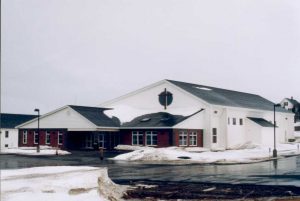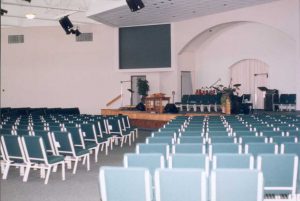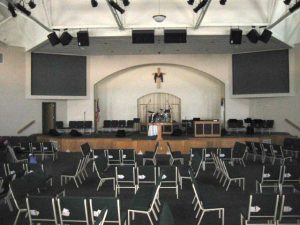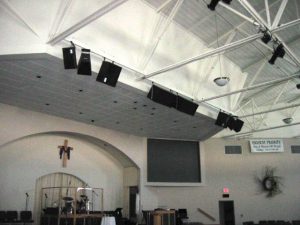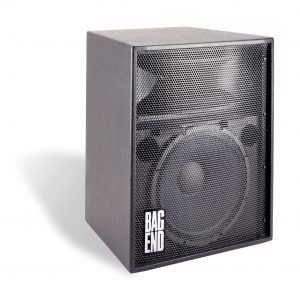Presque Isle Wesleyan Church, ME
All Installations Aren’t Created Perfect But This Installer Stuck With it Until it Was
In the remote northeastern tip of the United States, far beyond the coastal Maine fishing villages that people “from away” come to visit each summer, the Aroostook River meanders through vast woodlands and rich farmland on its way to neighboring Canada. Here, U.S. Route 1 passes through the bustling community of Presque Isle, the “Star City” of Northern Maine.
Here is where this tale takes place. Presque Isle is home to the Presque Isle Wesleyan Church, whose congregation decided in late 1999 to build a 600-seat addition. They hired Greg Samuel, a local system integrator – also a member of the church – to design and install the perfect sound, video, control, and theater lighting system for the new facility.
“When you read an article about an installation in a trade magazine, it’s always perfect,” said Samuel, owner of The Maine Thing in nearby Stockholm, Maine. “Well this write up isn’t about a job like that. It’s about a job that didn’t turn out right. The customer wasn’t happy and I wasn’t happy either.” But thanks to his perseverance, and an assist from loudspeaker manufacturer, BAG END Loudspeaker Systems of Barrington, IL, the story had a happy ending – eventually.
“What I asked for and didn’t get was any acoustical treatment for the main sanctuary. The calculated RT60 numbers were bad and it was obvious that the untreated walls would cause flutter echo problems.” He said. “But the architect was sure the building would sound great, so the church board declined my recommendation to add more treatment to the project. They felt the acoustical roof deck and thin layer of acoustical wall covering on the rear wall would be enough. So I was stuck with lots of bare gypsum wallboard and had to design a system that would work in that environment.”
After losing the battle to treat the room, Samuel wanted to install loudspeakers that would minimize potential room problems. Working with the engineers at BAG END Loudspeakers, he set up an LCR system using nine BAG END Opal high output speakers flown in three clusters across the front of the church at a height of 21 feet. He used a BAG END ELF-M (Extended low frequency) integrator and a pair of BAG END D18-E dual 18-inch subwoofers mounted at floor level under the front of the platform for the bass. He also used BAG END TA-2000CF monitors to deliver six clean, accurate foldback mixes.
“I liked the Opals because they array well and have tight pattern control. The church wanted full stereo coverage for the seating area, so I needed a speaker system that would provide 140 degrees of horizontal coverage from each array. The long-throw Opals seemed to be just what we needed to punch sound to the back and side seating areas without exciting the rear and side walls, while the ELF subwoofers had the smooth low frequency response I thought would work well in a reflective space. By specifying a center cluster for speech, I successfully minimized multi-path intelligibility problems.”
But Samuel could never get the system to perform as well as he thought it should. “The church staff wanted a warm, full sound,” he said. “I just couldn’t achieve that sound.” He ran test after test and tried everything he could with EQ to get the sound they wanted, but there was little improvement. “The more I worked with the room, the more frustrated I became, Samuel said. “The Opals covered the room as designed and speech sounded great. It was intelligible and you could hear every syllable. Nobody complained about speech. Prerecorded music even sounded good. But we couldn’t get live music to sound good at all. Most people thought it was fine, but the critics were never happy. They said it either sounded tinny, distant or muffled, or they’d complain that they couldn’t hear a vocal or instrument at all, while someone else said the same source was too loud.”
According to Samuel, the room had serious acoustical problems that were not immediately obvious. “The combination of angled wall construction and a lack of acoustical treatment causes strange things to happen with sound,” Samuel said. “Sounds change pitch as they decay and there’s a very distinct flanging effect if you move through certain areas. It’s more than just a flutter problem.
Samuel found it nearly impossible to even measure the room with an analyzer. “Basically, my test equipment was worthless. You can’t trust your ears, either. The place is like an acoustic fun house. The room defies measurement. There are no two places in the room anywhere where the sound is the same because of all the weird acoustics.”
Samuel did the best he could to align and EQ the system and used the “bad acoustics” defense when anyone complained about the sound. It worked for a while. But when traveling groups came in with their own systems and got the sound they wanted, he felt he really needed to see if there was anything else he could do to make it right.
“One group came in and I offered them our system, which would have been so much easier. It was four vocalists with soundtracks.”Samuel recalled. “Why would anyone want to unload a whole busload of gear just for that? But they refused to use our system and brought in a pair of crummy speakers on stands. Everybody thought it sounded so good. It didn’t cover the house as well as our system, but it had the sound they wanted. I really couldn’t argue with the results.
Samuel was baffled. “This really put me in a tough spot because I had installed an expensive system and couldn’t get the sound they wanted. But somebody else could come in with 1/10 of the system and get results. I had to do something.” The whole experience was becoming a disaster. He needed a different approach.
“Up to that point, most of the discussion was theoretical. Obviously, the major problem was room acoustics, and there was nothing I could do about it. But if someone could get better sound out of a portable system, then there had to be more to the mystery,” Samuel said. “It was either a loudspeaker issue, a loudspeaker location issue, an EQ and delay issue, or some combination of issues. Adjusting EQ was easy, but I had pretty much exhausted that route. Trying different loudspeakers or moving them around was not going to be easy. The existing arrays were 23 feet above the floor and impossible to move without a lift and expensive rigging. And even if I came up with a better solution, the church wasn’t going to pay for any more sound system work.”
So Samuel offered to try different solutions at his own expense. The first thing he wanted to do was rule out the loudspeakers as the source of the problem. Since he was doing an install at another church using a pair of BAG END TA5000 speakers, he brought them in to the Presque Isle church see how they sounded. “I was amazed at how good they sounded,” Samuel said. “I had the staff pastors listen them and they said, ‘That’s the sound we want – a warm, full sound.’ What I had provided with the Opals was a clear and accurate, although distant sound.
Pleased with those results, he did further testing by temporarily flying a pair of TA5000s next to the Opals for AB testing. “In that room, the TA5000s just blew away the Opals,” he said. “Source material that sounded distant through the Opals literally jumped right out when played through the TA5000s at the same level.” Armed with these initial tests, he contacted the folks at BAG END factory and related his tale of woe.
“They were very supportive, although they were skeptical that the TA5000 would outperform an Opal.” Samuel said. “I was doing a lot of experimenting at that point and kept in close contact with Henry Heine, director of engineering and development for BAG END, and with Dan Saraceno in technical support. They were really great to work with. I was most impressed at their willingness to listen to me. They took me very seriously and genuinely wanted to make the project a success. Their commitment was to ‘do whatever it takes’ and they did. This is a great company to work with.”
After extensive testing and consultation with the folks at BAG END, Samuel came up with several conclusions. “We were basically using the wrong speakers for that space. The Opals are high output, long-throw speakers. They just don’t sound good when flown close to the seating area in a highly reverberant space. They have a lot of punch in the midrange and can really punch the sound back 75 to 150 feet. Outdoors or in a large venue, they’re phenomenal. But you really don’t want to stand much closer than about 25 feet.” There were more than just the technical issues.
“Other customers playing other styles of music would have been very satisfied with the Opals in that space. A lot had to do with expectations and taste,” he said. “The fact that the church preferred a different tonal quality from the loudspeakers was probably as much of an issue as the problems I couldn’t overcome. They wanted warm and fuzzy, like their home stereo sound. It’s hard to get a warm sound in a harsh, reverberant space with any speaker, and I certainly couldn’t get it with a high-output, long-throw speaker. But the TA5000 is a short to medium throw unit with a wide pattern and a full, rich sound. It’s very forgiving and seems to work well in most any environment.”
Samuel conducted a number of experiments to find the right flying location and the right combination of speakers to fit the room. “The biggest obstacle I encountered was the same one I faced in the original design: I couldn’t really put the speakers where I wanted because they would block the sight lines to the two 9’ x 12’ video screens located above each side of the stage,” he said. “I tried to think out of the box and actually tried mounting them above and behind the stage in front of the proscenium arch. I flew a pair of TA-5000s and a pair of D-18 ELF subs up there and it really sounded awesome. That’s definitely the sweet spot of the room. A single pair of speakers with 90 x 50 horns covered the entire seating area. Since they were above and behind the stage, the musicians got the “house mix” they always wanted, and I was surprised at how few feedback problems I had in that location.
”Unfortunately, it caused timing problems and other artifacts. When the pastor spoke, he was 25 feet in front of the speakers, between the speakers and the audience. The congregation heard direct sound from him, reinforced sound from the speakers behind him, and reverberant sound all arriving at time differences long enough to cause a distinct echo. One of the delayed signals even had a lower pitch. Obviously, that didn’t work, so we had to scrap that plan.”
His next approach was to try new arrays out front using a pair of TA5000s to cover the main seating area and a pair of Opals for the side seating. “I used two TA5000s for the main seating area, which gave us the warm coverage that everyone wanted. The two Opals filled the side seating areas where pattern control is more critical. After having the speakers behind the stage, the musicians were reluctant to allow me to move them back out front. But we couldn’t live with the delay problems. Delivering the spoken word was still our primary mission, and it had to sound good.
“So I compromised by adding a pair of flown TA2000 speakers pointing back for stage fill to give them the on-stage sound they liked,” he said. “I rotated the horns so they have an 65 x 80 coverage, which basically covers the whole platform. I run them off the mono buss as a pseudo house mix. They really like it.” The last step was to find a place for the subwoofers.
“Generally, subs go on the floor,” Samuel said. “I agree with the accepted thinking that low frequencies are mostly omni-directional and that we generally feel bass better at floor level. But I’ve found putting them on the floor only works when you listen at a distance.
“In our sanctuary, the seating area is very close to where the subs were located. Listeners on the front rows were six feet away from the subs and 23 feet away from the flown arrays, while listeners in the rear were more equidistant from each set of speakers. These differences not only affect timing, which is more critical in a poor acoustical space, but close listeners get uneven frequency response relative to distant listeners. So I flew the subs overhead in the center. But once again, the sight line issues became a problem and I had to fly the pair of dual 18-inch cabinets horizontally. Unfortunately, that gives me a nice horizontal line array across the front with the result that I have a vertically directional low bass pattern. I still have uneven coverage!”
The bottom line? “It was the best compromise we could come up with under the circumstances. I can live with it, the people at the church are very satisfied, and I think the folks at BAG END are pleased that I worked hard to preserve their reputation” he said.
“They really came through on their promise to do ‘whatever it takes’ by adjusting my original order and taking back three of the nine Opals. I bought four of them for my rental kit, so together we were able to provide the church with better loudspeakers for the application. The experience has been good and I’ve learned a few things, including always try to determine what kind of sound your customer thinks he wants and consider walking away from a job where the customer isn’t willing to budget for the acoustical treatment that will optimize the sound.”
![]()
![]()
![]()
![]()

